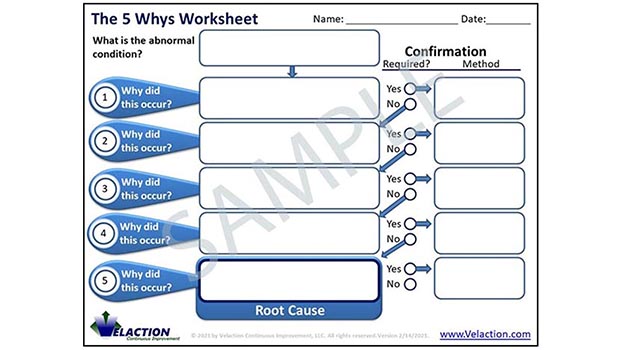🛠 > Lean Forms & Tools Directory > Download Free Forms & Tools
5 Whys Form
The 5 Whys form is a simple tool that helps improvement teams find the root cause of a problem. This simple form documents the problem solver’s progress.
Velaction’s version of the 5 Whys template adds in a unique feature: the confirmation step. One of the drawbacks of the 5 Whys is its limited use of data. The confirmation step requires the problem solver or team to consider whether the presumed cause needs confirmation, and what that confirmation method should be.

In many cases, using the five whys in problem-solving can be done on the fly. There is no need to write down or document this root cause analysis on a form when it is done for a simple problem or a daily kaizen activity.
When the project involves a team, though, recording the thought process helps with communication. Anyone on the team can see how a problem solver arrived at his or her conclusions. It saves a great deal of time talking about the problem-solving process that was used and lets the team focus more on coming up with solutions.
This tool is also useful for training purposes. It allows a mentor to review how the mentee thinks about solving problems. There is a tremendous amount of teaching value in seeing this thought progression written out on the five whys form.
Finally, another large benefit of this form is the confirmation step. One of the drawbacks of the five whys is that it is not a rigorous scientific tool. A single person might come to different conclusions when using it on different days. It is also possible for different people to come up with a different outcome when attacking the same problem. Part of this challenge is that problems seldom have a single root cause.
But there is also the issue that assumptions can work their way into the five whys. This five whys form slows people down and asks them to confirm each progressive cause before proceeding to the next one. If they can’t confirm, they are on the wrong track.

This form can be something of a coach to you. Two of the challenges you face in your problem-solving efforts are a lack of practice and less coaching than you probably need.
The first issue comes from the fact that you are often tied to a process and might only spend a few minutes of your day on kaizen, if that much. Even within a great continuous improvement culture, your skills can atrophy if they are not used on a regular basis. The five whys form is a great refresher for your training.
As for the second issue, even the best of managers is outnumbered by his team. To get better, you need every advantage you can find. Tools such as this five whys form help you focus on using problem solving methods consistently when dealing with issues.
That consistency drives better results, which tends to make your job easier. An added bonus is that becoming an effective problem solver tends to make you stand out from your peers.

This form improves the quality of your team’s problem-solving efforts, especially when they are inexperienced. The structure provided by the five whys worksheet keeps them from taking shortcuts and straying from a good problem-solving methodology. This benefit means not only better results, but also more good results. If people solve problems quicker and with less rework, more issues end up being worked on.
The confirmation step, in a small way, acts as your voice in your team members’ heads. When they get to that little block, they should think of you. That will tend to happen more if you are focused on facts and data when you discuss problems with your team members. If every time you talk to them about an issue, you make them prove their case logically and quantifiably, then every time they uncover a subsequent cause of the problem, they will consider what you would ask them. If you demand rigorous investigation of problems before taking action, this form will reinforce that.


6 Comments
ahmedab · October 19, 2012 at 6:31 am
Thats a quick and easy way to learn
Jeff Hajek · October 19, 2012 at 6:36 am
Ahmedab,
Thanks for the compliment. Always nice to hear when our stuff is helpful to people.
Regards,
Jeff
adityak · April 29, 2012 at 6:41 am
It’s excellent and simple form…I will use it and to translate to my language…hope it works in my environmet…thanks
rcoelho · March 13, 2012 at 8:26 am
simple & too the point. why do some folks make his too complicated?
Jeff Hajek · March 13, 2012 at 8:53 am
Thanks for the compliment. I think most of the Lean tools are really pretty simple.It is getting the discipline and culture to use them regularly that is the hard part.
aims35 · October 12, 2011 at 1:42 pm
This is the most helpful site I have seen for couple of years working as a Lean Process Engineer. For members, the free forms are great to tag with continuous improvement initiatives.
Aim